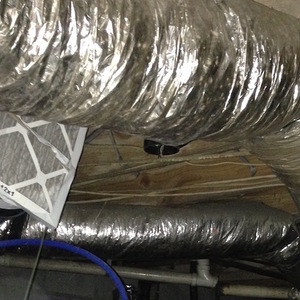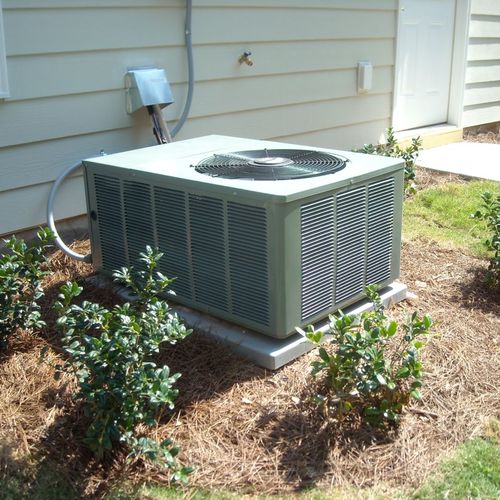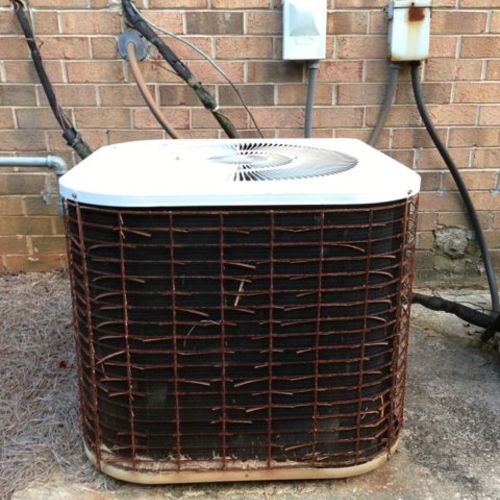
I never read Robert Fulghum’s book, All I Ever Needed to Know I Learned in Kindergarten, but I have a clear memory of learning about one thing in the book: Most of the dust floating around our homes is actually made up of skin flakes. Now, I don’t know if that memory is accurate (maybe it wasn’t from Fulghum’s book?), but I have found out that this tantalizing “fact” about dust and skin flakes isn’t true. Household dust, it turns out, isn’t made up largely of skin flakes. (See this article about a 2009 study on household dust.)
Household dust and air conditioner coils
That doesn’t really let skin flakes off the hook, though. There’s still enough of them floating around that they can cause a problem if they find their way into your air conditioner.
HVAC technicians deal with dirty coils all the time. See that photo at the top? That’s a really bad one. Almost no air can get through all that gunk. I did a kind of postmortem on that coil a few years ago, but my focus was on the performance of the air conditioner, not indoor air quality.
Just so you know what an air conditioner’s evaporator coil is supposed to look like, here’s a photo of a nice, clean coil. No gunk. No sludge. Just a bit of water that had condensed on the cold metal fins on that summer day in Atlanta. Air can move through the coil.
![A clean air conditioner coil with no skin flakes. [Photo credit: Energy Vanguard]](https://images.greenbuildingadvisor.com/app/uploads/2019/05/05193133/air-conditioner-coil-clean-fins-air-flow-800-700x438.jpg)
When that stuff gets pulled into an air conditioner and finds a wet coil, it sticks. Over time, that gunk creates its own little ecosystem because guess what: There’s life in them there particles! My friend Kristof Irwin has discussed this issue of the microbiome in his Building Science Podcast more than once. (And that’s only one reason you should go listen and subscribe!)
The problem with skin flakes
At the end of 2017, researchers in Hong Kong published a paper titled, Skin squames contribute to ammonia and volatile fatty acid production from bacteria colonizing in air‐cooling units with odor complaints. Squames are what I’ve been calling flakes; they’re pieces of skin that fall off our bodies all the time. The plain English translation of the title would be: Skin Flakes and bacteria combine in your air conditioner to create bad odors. (Here’s a nice summary of the paper.)
Skin flakes have proteins in them. Bacteria, which are everywhere, chow down on the proteins. An eventual waste product from this process is ammonia. So if you ever smell something like urine coming from the air conditioner, this could be the reason.
But wait… there’s more! In addition to the proteins, skin flakes also have fatty acids. That leads to another bacteria chow-down with a different waste product smell: body odor.
What can you do to keep these urine and BO smells from emanating from your air conditioner? It’s pretty easy. Make sure your return ducts are sealed and that you have a good filter with no bypass. Just a few months ago I wrote about seven reasons your filter isn’t doing its job. Fix those problems and use a good, high-MERV filter designed properly to have a low pressure drop.
Allison Bailes of Decatur, Georgia, is a speaker, writer, building science consultant, and the author of the Energy Vanguard Blog. You can follow him on Twitter at @EnergyVanguard.
Weekly Newsletter
Get building science and energy efficiency advice, plus special offers, in your inbox.















One Comment
We shed ~1 million skin cells every day. Approximately 8lbs per year.
bg
Log in or create an account to post a comment.
Sign up Log in